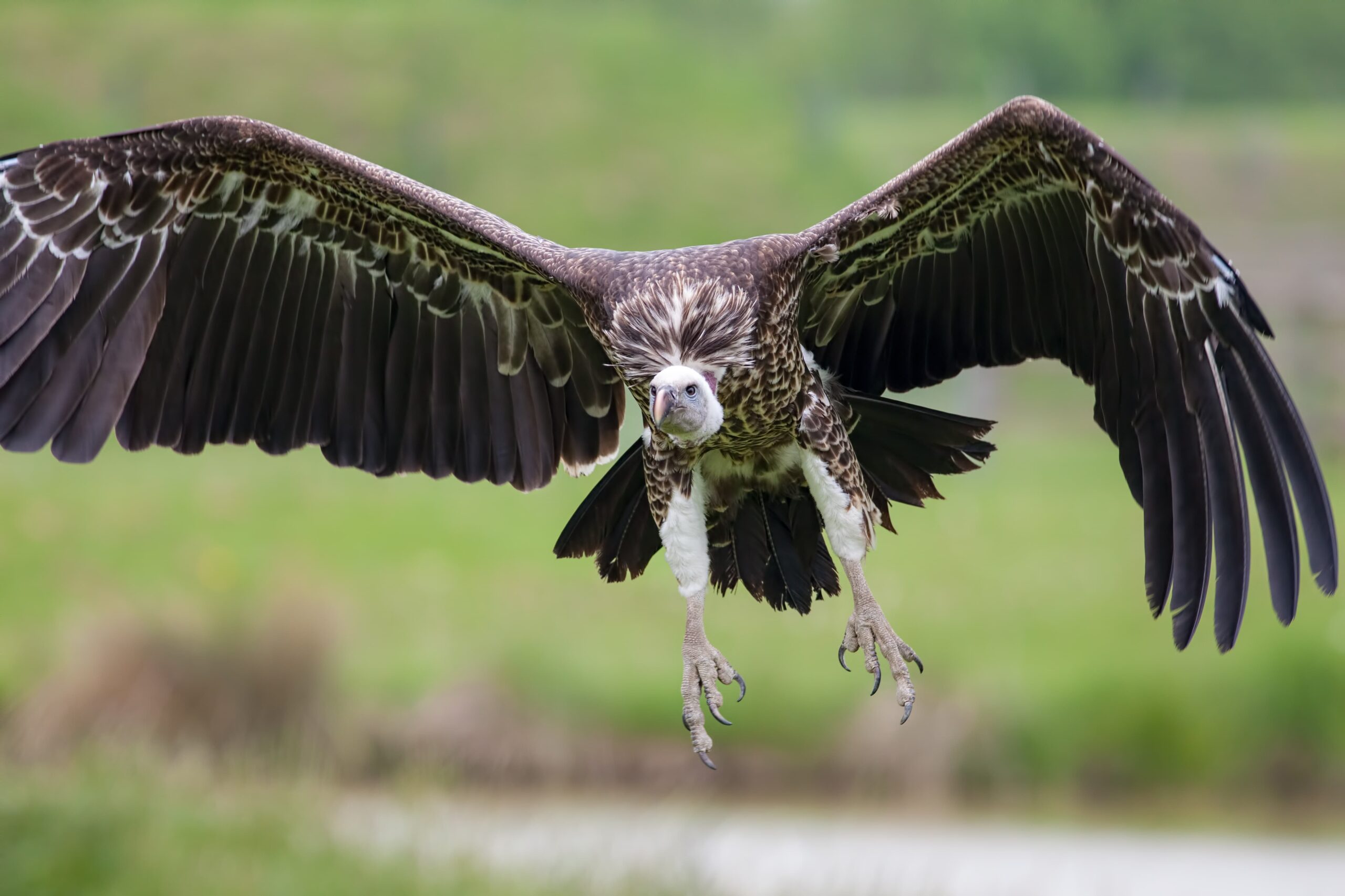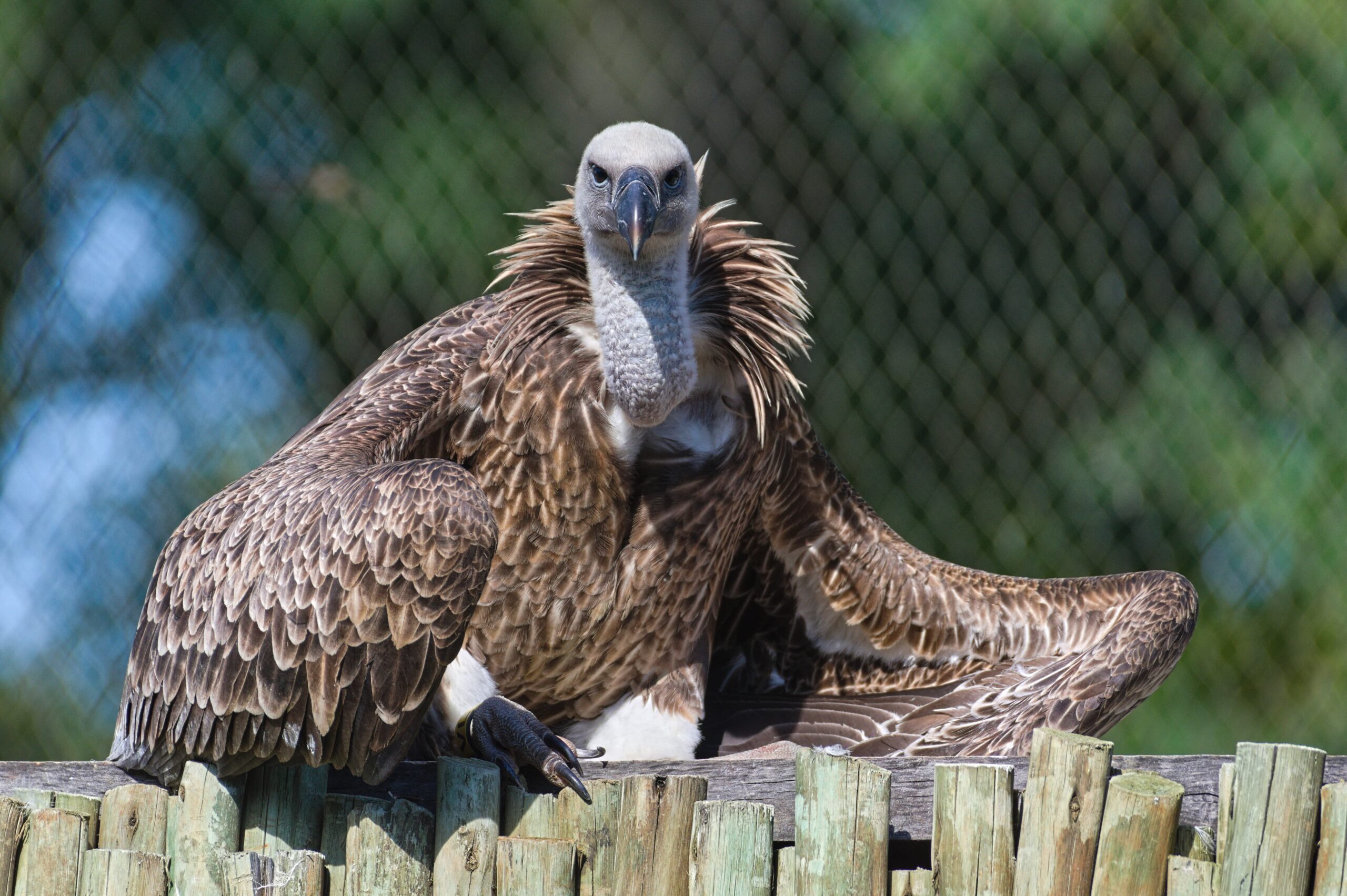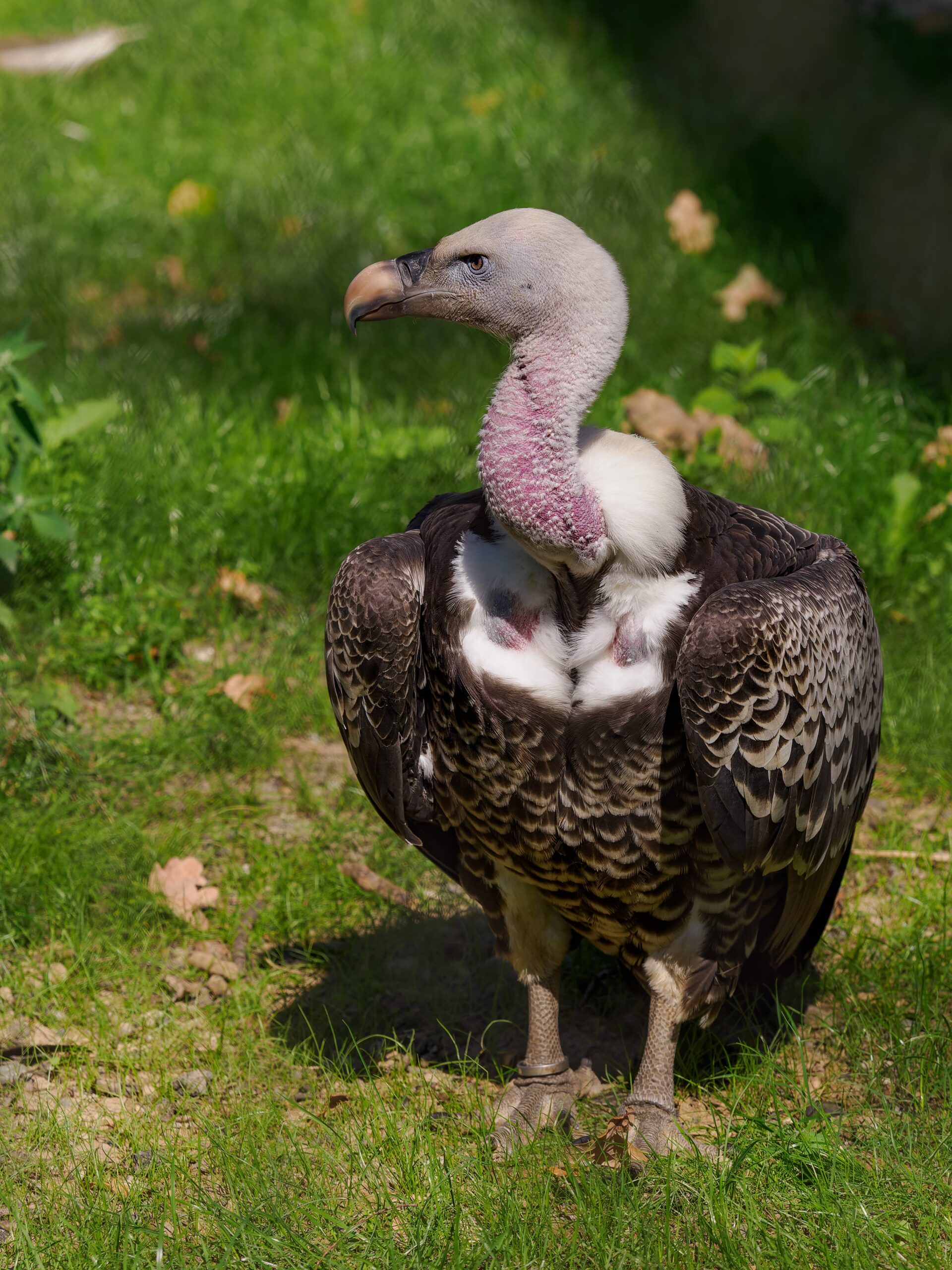Rüppell’s Vulture Profile
Vultures often have a look about them. There’s a fierce sort of intelligence behind a fixed and thoughtful glare. Their bare necks give them a sort of Hollywood villain image and their hunched shoulders have been mimicked in Disney cartoons as a symbol of darkness and treachery.
But in reality, they’re worthy of a lot more respect. Theirs is a dirty job, but someone has to do it. And this unfair portrayal causes tremendous harm to the conservation efforts of what is an essential ecosystem engineer.
The Rüppell’s vulture is one of the largest and embodies everything a classic vulture should: a circling harbinger of death on the African plains.

Rüppell’s Vulture Facts Overview
| Habitat: | Savanna, Shrubland, Grassland, Rocky areas, Desert |
| Location: | Sub-Saharan Africa, Mostly North of DRC, The Horn |
| Lifespan: | Up to 50 years |
| Size: | Up to 1 meter(39 inches) tall, 2.5m (8 ft) wingspan |
| Weight: | 9kg (20lb) |
| Colour: | Mottled grey/black |
| Diet: | Exclusively carrion |
| Predators: | Mostly humans |
| Top Speed: | Unkonwn, cruises at around 35 km/h (22mph) |
| No. of Species: | 1 |
| Conservation Status: | Critically Endangered (IUCN) |
The Gyps genus is a group of powerful Old World vultures, known as the Griffon vultures (though this name sometimes refers specifically to the Eurasian Griffon Vulture). There are eight species, of which Rüppell’s vulture is one of the most endangered.
They are exceptionally high-flying carrion feeders, faced with a bombardment of human-caused destruction and in desperate need of better protection.
Interesting Rüppell’s Vulture Facts
1. They’re griffon vultures
Gyps vultures are some of the largest and strongest vultures. This is a genus that boasts such heavyweights as the Eurasian griffon vulture and the Himalayan vulture.
This is a very widespread genus, spanning all of Africa, much of Asia and continental Europe.
Until recently, in Africa and India, more than 90% of vulture sightings would have been a member of the Gyps genus. Sadly, populations have taken a catastrophic tumble, and some have declined by over 95%. 1
2. They’re carrion specialists
Rüppell’s vultures are exclusive carrion feeders, meaning they don’t kill their own food like some of the other large species, and they don’t tend to eat bone, but the decaying fleshy matter rotting off nice juicy corpses.
This is a heavy bird, so it uses thermals and winds to stay afloat. They circle at tremendous heights, using keen eyesight to spot a deceased animal. Once found, they swoop down, then perform a sort of excited jog toward the body with their wings stretched out and their necks extended toward it.
Then they’ll find the easiest access point into the carcass, which is often the anus, and bury their heads up the shoulders to get at the juicy innards.
This should explain why they’ve evolved to have bare necks.
This feeding strategy requires a strong stomach to watch, let alone employ, and the vultures are well-equipped to handle it. Powerful stomach acids destroy such micronasties as cholera, anthrax, and botulism, and these birds act as biological cleansers; ridding the ecosystem of pathogens.
These birds specialise on older animals – ones who have died of natural causes, rather than those hunted by other predators. They’ll follow the seasonal migration of large mammal herds, often aggressively defending their discoveries against other species of vulture.
A vulture like this doesn’t use its sense of smell to find food, but its eyes are particularly powerful, allowing it to scan the ground from record-breaki9ng heights. 2
3. They’re high-altitude specialists
Bird respiratory systems are quite special. Unlike our inefficient and laborious breathing which requires us to first blow out used air before we can bring in a new batch, birds have a continuous flow of oxygenated air passing over their lungs, thanks to a clever arrangement of air sacks that work in conjunction with their lungs.
It’s now thought that this system may have come before flight evolved in birds, but it certainly didn’t hurt to have the most efficient respiratory system in the animal kingdom when choosing to relocate to high altitude.
But even among birds, this vulture is impressively adapted for heights. Haemoglobin is a protein in blood that’s used to carry oxygen and carbon dioxide around the body as part of the respiration process, and in Rüppell’s vultures, this molecule is modified to be extremely good at its job.
In humans, the low pressure of high altitude makes it difficult for oxygen to bind to this protein, but the modified subunit found in these birds is much quicker to grab any oxygen it can get, allowing the vulture to breathe efficiently at extreme heights. 3

4. They’re the highest-flying bird
This adaptation has allowed the Rüppell’s vulture to defy all other birds and it is the highest flying bird known so far.
This fact was established when a passenger plane, cruising at over 11km up, minced one with its engine.
The engine was wrecked, and the bird certainly didn’t fare any better, but there was enough biological fallout wrapped around the jet to identify the species, including fifteen bits of feather.
This beat the previous observations of mallards at 6.4km, and geese at 8.8km, but since it’s such a bizarre occurrence that hasn’t been corroborated by any other observation, it’s thought this might have been a bit of an accident.
Perhaps the bird was caught in a storm or forgot which way was down. Or maybe they really do push the limits of what’s possible for manual flying. 4
5. They’re in a lot of trouble
Airstrikes aren’t the main threat to this species.
By 2012, this species was listed as endangered, and already by 2015, it was moved up to Critically Endangered by the IUCN.
The list of threats is one we’ve seen time after time, populated by a terrible diversity of destructive forces that affect vultures all over the world, and are harming every species of African vulture.
Habitat conversion is wiping out natural feeding grounds and bringing the species into direct conflict with livestock farmers, who erroneously think the birds are killing their flocks.
The wide range of this bird means it’s impossible to create protected areas for them, and even within such zones, wildlife populations are declining. But the main concern is poisoning. Diclofenac used in treating livestock is lethally toxic to vultures, and has claimed countless lives as a result.
The species is also heavily traded in West Africa, at fetish markets; one study counted between 1100 and 1700 birds sold in such places over a six-year period, estimated to be a significant fraction of the local population.
They’re also used in traditional medicines, witchcraft, and even illegal international trade. Electrocution on powerlines is also proving to be a common cause of death. 5
6. Conservation efforts are underway
Conservation in African vultures does seem like an uphill battle, with so many independent factors contributing to their rapid decline.
But organisations like the Peregrine Fund focus on tracking and monitoring populations to try and find more clues to their protection.
Outreach programs also put a strong focus on community education, helping to contextualise the importance of such animals in the grander scheme of ecosystem services. In Kenya, there’s particular focus on Masaii children, with the facilitation of mentorship programs in which older community members teach the younger generation about the importance of a healthy environment.
Further, the installation of livestock protections reduces the incentive for farmers to lay poisons, and educating local people on how to respond to poisonings quickly hopes to battle the chemical aspect of vulture decline over the coming generation.

Rüppell’s Vulture Fact-File Summary
Scientific Classification
| Kingdom: | Animalia |
| Phylum: | Chordata |
| Class: | Aves |
| Order: | Accipitriformes |
| Family: | Accipitridae |
| Genus: | Gyps |
| Species: | rueppelli |
Fact Sources & References
- V. Prakash (2003), “Catastrophic collapse of Indian white-backed Gyps bengalensis and long-billed Gyps indicus vulture populations”, Science Direct.
- “RUPPELL’S GRIFFON VULTURE”, Smithsonian’s National Zoo & Conservation Biology Insitute.
- GrrlScientist (2011), “Mystery bird: Rüppell’s griffon vulture, Gyps rueppellii”, The Guardian.
- “Rüppell’s Vulture”, The Peregrine Fund.
- “Rüppell’s Vulture”, IUCN Red List.
